Industries have seen customer relationship management (CRM) become one of the most essential tools for business growth. Businesses have an interest in tracking their regular customers from the very beginning, offering them a better experience and attracting new customers. This interest led to the birth of the traditional CRM system.
Add to that the need to track vendors and partners, determine where the best relationships are in place, and find out what the most efficient way to collaborate with these other businesses is, and you can see how CRM becomes a rather complex endeavor.
Over time, it turned out that having such platforms hosted in house, while absolutely providing increased value, encountered new challenges when faced with a mobile workforce. The cloud was there to support this sorely needed expansion.
The next logical evolution happened somewhat in parallel with the move to the cloud. Organizations are recognizing that a simple system, on its own, cannot provide the value needed for the business to gain an edge over its competitors. As such, the tools evolved again, integrating with other essential tools in the organization, as well as with various social channels.
The last few years have seen a merger of the core enterprise resource planning (ERP) platforms with the classic customer relationship management platform. This results in better end-to-end processes across the entire organization, and better visibility into where the biggest issues are within an organization. The end results provide better customer experience and a faster and better service, while adapting to the customers' growing online presence.
Dynamics 365, now joining under its umbrella with both CRM and ERP functionality, is Microsoft's response to a growing trend. It is a set of robust business applications, with a long history and presence in the market, all brought together to maximize an organization's performance and homogenize its data.
This book focuses on the functionality, which was formerly part of the CRM platform. While at times we might touch on some of the newer offerings, we'll be spending most of our time focusing on the revamped modules for Sales, Customer Service, Field Service, Project Service, and Marketing. We'll also be looking at the new paradigm and features offered through the Power Platform. As the new kid on the block, the Power Platform quickly gained popularity by not being entirely dependent on the typical CRM functionality, but rather by allowing us to build brand new functionality for the organization in a much simpler and rapid manner.
The following topics will be covered in this chapter:
- What is Dynamics 365 really?
- Global data center locations for Dynamics CRM Online
- What do you need to customize Dynamics CRM?
- Opening a free 30-day trial of Dynamics 365 for Sales
- Configuring a domain name for your environment
- Integrating with Office 365 E3 trial services
In this chapter, we will first look at what environment we need to complete the examples presented in this book. We will create a new environment based on a Microsoft Dynamics 365 Online 30-day trial. This approach will give us the means to experiment with a trial environment for free.
Let's get started!
Understanding what Dynamics 365 really is
Dynamics 365 is an umbrella marketing term describing several platforms and functional products. The various applications under this branding include the following:
- Sales
- Customer Service
- Field Service
- Human Resources
- Finance and Operations
- Retail
- Project Service Automation
- Marketing
- Artificial Intelligence
- Mixed Reality
- Business Central
A detailed look at these applications will show that, at their core, these are the next evolution of the Dynamics CRM, Dynamics AX, and Dynamics NAV platforms. Some have organically evolved into what they are now, while others have received a major update with the move under the Dynamics 365 umbrella.
As mentioned before, the focus of this book is centered around the former Dynamics CRM platform, and how the separate modules evolved from it, becoming the following:
- Dynamics 365 for Sales
- Dynamics 365 for Customer Service
- Dynamics 365 for Field Service
- Dynamics 365 for Project Service Automation
- Dynamics 365 for Marketing
Whereas before, you were buying a package that included most of these, now you have the flexibility to select only the modules you need when choosing the cloud SaaS offering. This allows your organization to start with, let's say, Sales, and later expand into Customer Service.
Note that if you still choose to purchase the on-premise deployment option, which continues to be available, you will continue to get the same model that we've all seen in Dynamics CRM, with modules for Sales, Service, and Marketing. But the real value is in the cloud offering, where additional services and functionality are abundant.
Along with the standard platform functionality provided, we have a wide range of customization options, allowing us to extend and further customize solutions to satisfy a large range of other business scenarios. In addition, we can integrate this platform with other applications and create a seamless solution spanning across multiple platforms.
While it is by no means the only available platform on the market today, Microsoft's Dynamics 365 is one of the fastest-growing platforms and is gaining large acceptance at all levels (from small to mid-size to enterprise-level organizations). This is because of a multitude of reasons, some of which include the following:
- The variety of deployment options
- The scalability
- The extensibility
- The ease of integration with other systems
- The ease of use
Deployment options include the SaaS (cloud) offering, which provides the most advanced functionality, the classical on-premise deployment, and (not as common anymore) a third-party hosted solution, which is just another model of an on-premise deployment.
A recent development gives us the ability to host a virtual Dynamics 365 (CRM) environment in Azure. This offloads the cost of maintaining the local infrastructure in a fashion similar to a third-party hosted solution, but takes advantage of the scalability and performance of a large cloud solution maintained and fully supported by Microsoft.
In the next sections, we will look at some of the benefits that Dynamics 365 provides.
Scalability
Dynamics 365 can scale over a wide range of deployment options—from a single box deployment (used mostly for development) to a cloud offering that can span over a large number of servers and host a large number of environments. The same base solution can handle all the scenarios in between with ease.
Let's now see some of the extensibility features.
Extensibility
Dynamics 365 is a rapid-development platform. While the base offering comes in prepackaged functionality for Sales, Customer Service, Field Service, Project Service, and Marketing, a large variety of solutions can be built on top of the Dynamics 365 platform. The extensibility model leverages the Common Data Model (CDM) along with the Common Data Service (CDS) for apps, which is also an integral part of the Power Platform. This allows power users, nondevelopers, and developers alike to build custom solutions to handle various other business scenarios or integrate with other third-party platforms.
Microsoft AppSource is a great example of such solutions that have been built to extend the core platform, and is offered for sale by various companies. These companies are called independent software vendors (ISVs), and they play a very important role in the ecosystem created by Microsoft. In time, and with enough experience, some of them become the go-to partners for various implementations.
If nothing else, AppSource is a cool place to look at some of the solutions created and search for specific applications. The idea of the marketplace became public sometime around 2010 and was integrated into Dynamics CRM in 2011. At launch, it was designed as a searchable repository of solutions. It is a win-win for both solution providers and customers alike. Solutions can also be rated, thus giving customers better community feedback before they commit to purchasing and implementing a foreign solution into their organization.
When navigating to the AppSource home page, you will be presented with a search option right at the top of the screen, as shown in the following screenshot:
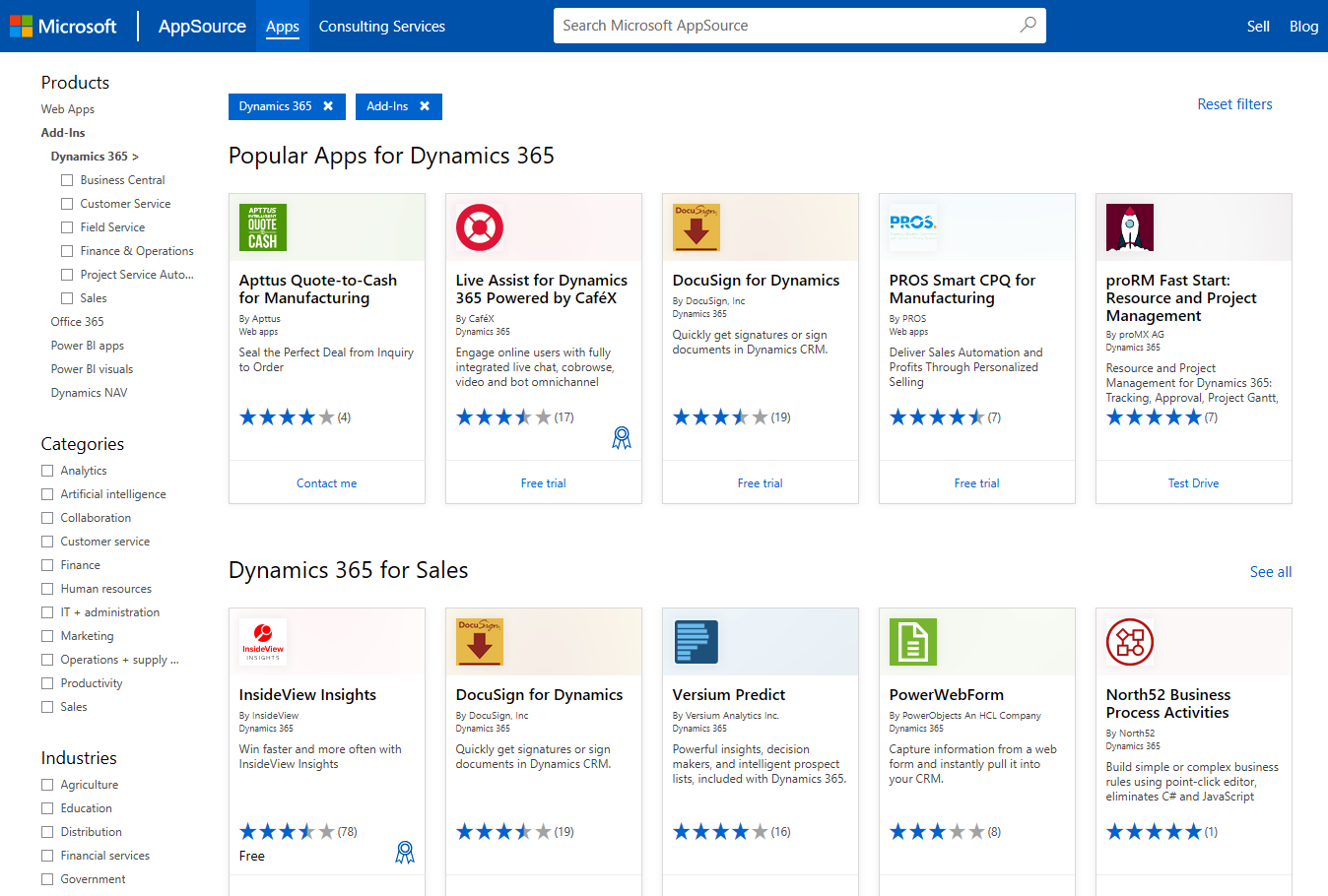
Now you have the option to filter your results by platform/product, standard categories, or industries. In addition, you can easily search for a specific solution using keywords or the name of the solution or ISV.
When searching for a solution provider, all solutions from that provider are listed, and you can further drill down by using the choices in the sidebar.
As mentioned previously, the community rating is clearly visible and provides the necessary feedback that you should consider when evaluating new solutions.
In addition to third-party and ISV solutions, starting with Dynamics 365, your organization might now choose to create a specific line of business applications and make them available to specific user groups. You can access these by extending the Dynamics 365 dropdown from the top-most navigation bar. This will bring up the left pane, which lists the standard Microsoft solutions and any other custom solution provided by the enterprise, as follows:
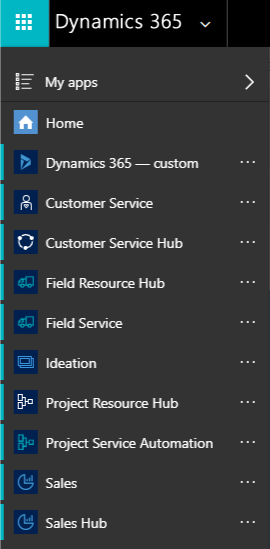
Microsoft recognized early on that a disparate system does not hold as much value as an integrated one. As such, various capabilities have been provided for better integration. In addition, some of the partners in the ecosystem have also provided their own solutions. Let's look at some of these capabilities in the next section.
Ability to integrate with other systems
There is a large variety of integration options available when working with Dynamics 365. In addition, various deployment options offer more or fewer integration features. With the Dynamics 365 Online (SaaS) model, you get more configurable integration options with cloud services, while the on-premise solution typically requires a more intensive effort to achieve integration. Here is where third-party tools shine.
You can use specific connectors provided by either Microsoft or other third-party providers for integration with specific solutions. This again varies depending on the deployment model and the integration service or tools used.
Microsoft provides services such as Power Automate Flows or Logic Apps. These services provide a large variety of prebuilt connectors and facilitate a user-friendly experience when designing and implementing integrations with external systems.
When the aforementioned connector options are not available, you can still integrate with other solutions using a third-party integration tool. This allows real-time integration with legacy systems. Some of the most popular tools used for integration include the following:
- Kingsway Software: https://www.kingswaysoft.com/
- Scribe: http://www.scribesoft.com/
- BizTalk: http://www.microsoft.com/en-us/server-cloud/products/biztalk/
Let's look at some of the features that were introduced for better user experience in the next section.
Ease of use
Dynamics 365 offers users a variety of options to interact with the system. You can access Dynamics 365 through a browser (now with support for all recent versions of the major browsers).
In addition, a user can interact with the system directly from the very familiar interface of Outlook, or through the App for Outlook if you're using the web version. The Dynamics 365 connector for Outlook allows users to get access to all of the system data and features from within Outlook. In addition, a set of functions built specifically for Outlook allows users to track and interact with emails, tasks, and events from within Outlook. Similar functionality is now built into the App for Outlook.
Offline support still remains the biggest benefit of using the Outlook client. Data can be taken offline, work can be done while you are disconnected, and then the data can be synchronized back into the system when connectivity becomes available again.
For mobile users, Dynamics 365 can be accessed from mobile devices and tablets. Dynamics 365 provides a standard web-based interface for most mobile devices, as well as specific applications for various platforms, including Windows-based tablets, iPads, and Android tablets. With these apps, you can also take a limited sub-set of cached data offline, create new records, and then synchronize them back to the platform the next time you go online. The quality of these mobile offerings has increased exponentially over the last few versions, and new features are being added with each new release.
In addition, third-party providers have also built mobile solutions for Dynamics CRM. Resco, for example, is leading the pack with a very robust mobile client for Field Service with full offline support.
With the ability to build additional apps leveraging the unified interface, users can now also have a specific line of business application built for their mobile clients that is controlled at the enterprise level. For the most part, these apps can be built through configuration alone, and are an easy way for organizations to provide only specialized functionality to mobile clients, thereby removing clutter and making life easier for the user.
Global data center locations for Dynamics CRM Online
Dynamics CRM Online is hosted at various locations around the world. Preview organizations can be created in all available locations, but features and updates are typically rolled out on a schedule, which is faster in some locations than others.
The format of the Dynamics CRM Online Organization URL describes the data center location. As such, the standard format is https://OrganizationName.crm[x].dynamics.com.
The OrganizationName phrase is the name you have selected for your online organization. This is customizable and is validated for uniqueness within the respective data center.
The [x] represents a number. At the time of writing, this number can be anywhere between 2, 4, 5, 6, 7, 9, or no number at all. This describes the global data center that is used to host your organization.
Microsoft has chosen to disclose the locations of data centers used on the Office 365 site. The following screenshot shows the available locations at the time of writing:
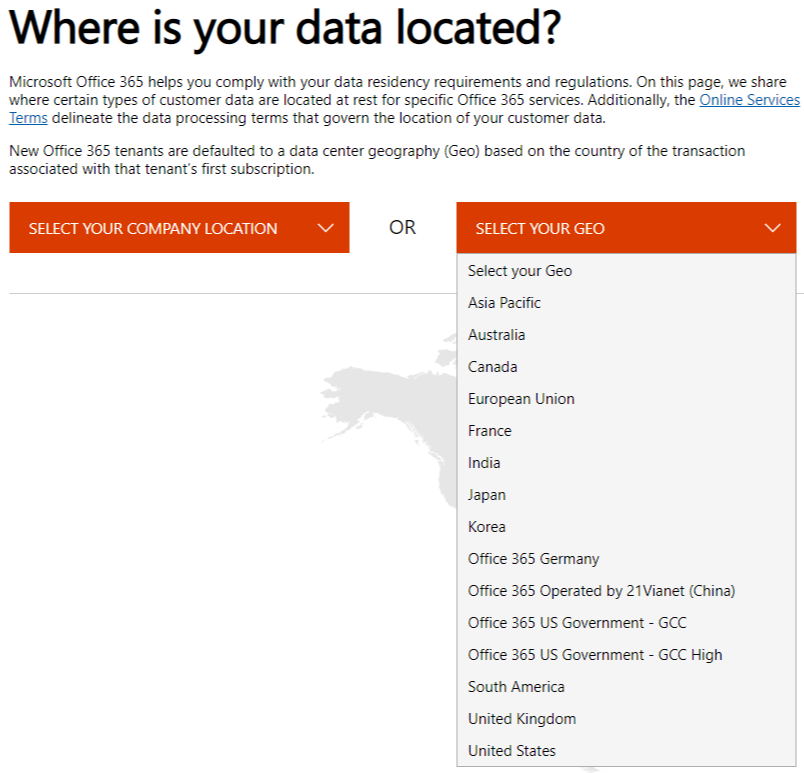
New data centers are being added on a regular basis. Some of the drivers behind adding these new data centers revolve around not only performance improvements, as a data center located closer to a customer will theoretically provide a better performance, but also a need for privacy and localization of data. Strict legislation around data residency has a great impact on the selection of the deployment model by customers who are bound to store all data locally to the country of operation.
These data centers share services between Dynamics 365 Online and other services, such as Azure and Office 365.
Advantages of choosing Dynamics 365 Online
The decision to select one hosting model over another for Dynamics 365 is typically driven by a multitude of factors, including, but not limited to, the following:
- The better feature set
- Financially backed uptime guarantee
- Extended compliance
- Scalability
- Time to market
- Integration with other online services
Over the last few years, there has been a huge increase in reliance on the cloud. Microsoft has been very focused on enhancing its Online offering and has continued to devote more functionality and more resources to support the cloud model. As such, Dynamics 365 Online has become a force to reckon with. It is hosted on a very modern and high-performing infrastructure. Microsoft has invested literally billions of dollars in new data centers and infrastructure. This allows new customers to forego the necessary expenses for infrastructure associated with an on-premise deployment.
Along with investments in infrastructure, the service-level agreement (SLA) offered by Dynamics 365 Online is financially backed by Microsoft. Depending on the service selected, the uptime is guaranteed and backed financially. Application and infrastructure are automatically handled for you by Microsoft, so you don't have to retain staff to handle these functions. This translates to much lower upfront costs, as well as reduced costs for ongoing maintenance and upgrades.
The Dynamics 365 Online offering is also compliant with various regulatory requirements and backed and verified through various third-party tests. Rules, regulations, and policies in various locales are validated and certified by global and local organizations. Some of the various compliance policies that are evaluated include, but are not limited to, the following:
- Data privacy and confidentiality policies
- Data classification
- Information security
- Privacy
- Data stewardship
- Secure infrastructure
- Identity and access control
All these compliance requirements conform to regulations stipulated by the International Standard Organization (ISO) and other international and local standards. Independent auditors validate standards compliance. Microsoft is ISO 27001 certified.
Furthermore, choosing the cloud over a standard on-premises deployment offers other advantages around scalability, faster time to market, and higher value proposition.
In addition to the standard benefits of an Online deployment, one other great advantage is the ability to spin-up a 30-day trial instance of Dynamics 365 Online and convert it to a paid instance only when you are ready to go to production. This allows customizers and companies to get started and customize their solution in a free environment, with no additional costs attached. The 30-day trial instance gives us a 25-day license instance that allows us to not only customize the Organization, but also test various roles and restrictions.
In the next section, we will learn about the prerequisites needed to customize Dynamics CRM.
Customizing Dynamics 365
First and foremost, in order to follow through with the information presented in this book, you will need an instance of Dynamics 365 Online. The following sections will describe in detail how you can obtain a 30-day trial instance.
In addition, in order to subscribe to a 30-day trial, you will need a Microsoft account (formerly called a Live account) or an existing Office 365 account if you will be associating this trial with your organization. You can obtain a Microsoft account by going to https://signup.live.com/.
The Create account page presents you with a sign-up form. In the username area, click on the Get a new email address link to create a new address:
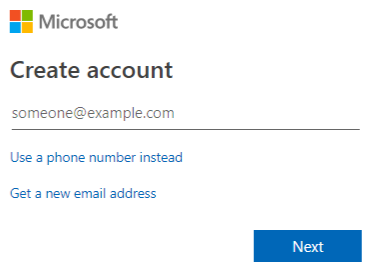
At the time of writing, you have a choice of outlook.com or hotmail.com for your newly created email address. The selected username is validated, as it must be unique.
Once your account is created, you will be logged into your new account and will see the welcome email. At this point, you can use this account to create your 30-day trial for Dynamics 365 Online.
While this book will not provide step-by-step instructions to be followed, it is strongly recommended that you have an environment available to supplement the material you will be reading and to familiarize yourself with the platform. In order to minimize the footprint and allow everybody to start quickly, I have opted to present all the topics based on a Dynamics 365 for Sales Online 30-day trial organization in the next section.
Opening a free 30-day trial of Dynamics 365 for Sales
In order to open your 30-day trial of Microsoft Dynamics 365 for Sales, you will need to go through a wizard-driven process that we will learn about in the following subsections.
Let's now proceed with provisioning a new 30-day trial.
Trial provisioning
Let's look at the steps to create a new instance:
- From the Applications dropdown at the top, expand Sales, and then select Overview.
- Review the features. Toward the bottom of the page, you will find a Get Started button. Note that, as the platform evolves, so does the home site; this link could be moved to another location on the page by the time this book reaches its audience. Regardless of its current location, you will still find a link to trigger the process to create your trial on the home site.
- Next, you will be presented with an option to either sign up for a free trial or request a callback. The second option involves receiving support from Microsoft, but the process is so simple that we will do it ourselves. Select Sign up for a free trial.
- You will then be directed to https://trials.dynamics.com/.
At the time of this writing, the trials page looks like the following screenshot:
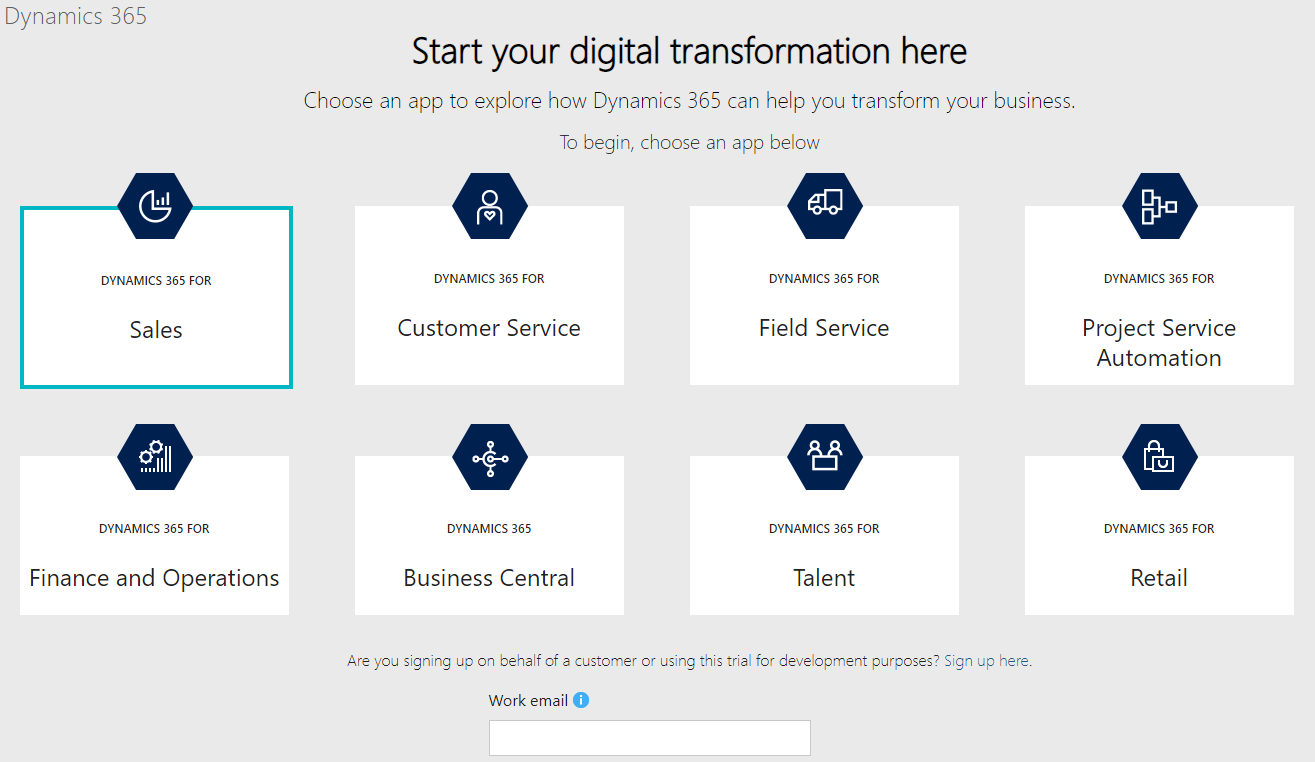
- Now, you could associate this trial with your existing Office 365 subscription tenant by logging in with an Office 365 account. Instead, we're going to find the Sign up here link right above the login area and click it. This will allow us to use a personal account that is not associated with a partner. In the pop-up window, select No, continue signing up. This will put us in the trial creation workflow:
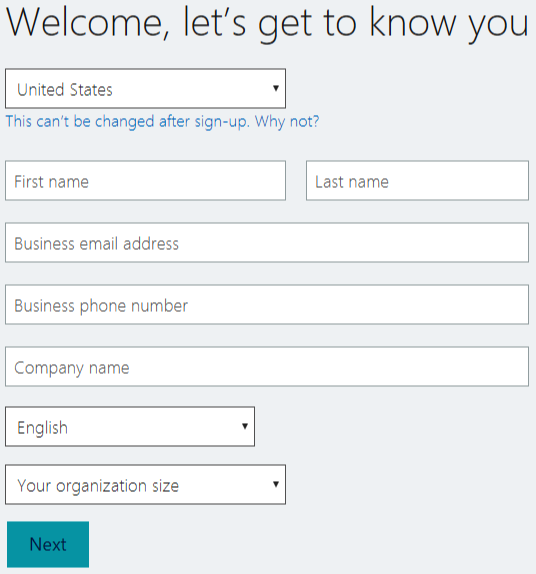
- Next, you will be prompted to create your organization and its first user:
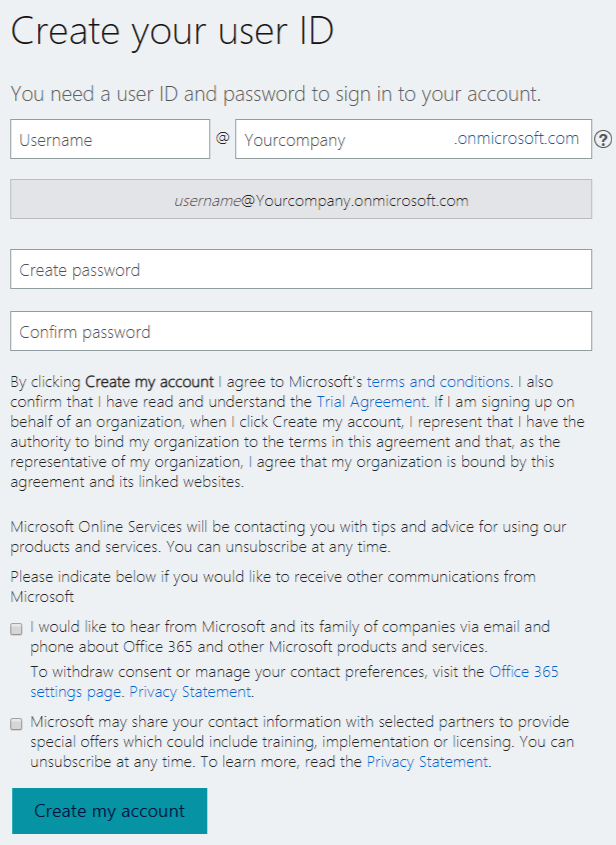
- Once you fill in the organization name in the Yourcompany field, this name will be validated for uniqueness. If everything is okay, then your new account will appear with a green checkmark in the gray bar below.
- Click on Create my account to continue.
- You will then be prompted to enter a mobile number for validation. You will receive a text message with a verification code. You need to enter it in the next screen and click Next. This triggers the process to create your instance:
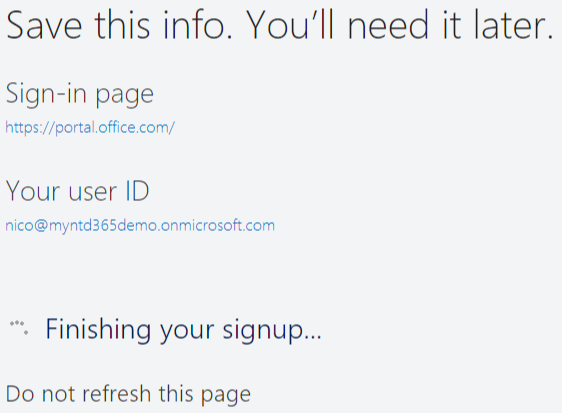
- When done, click on Set up to start configuring your new instance. You need to perform the configuration before anything is accessible:
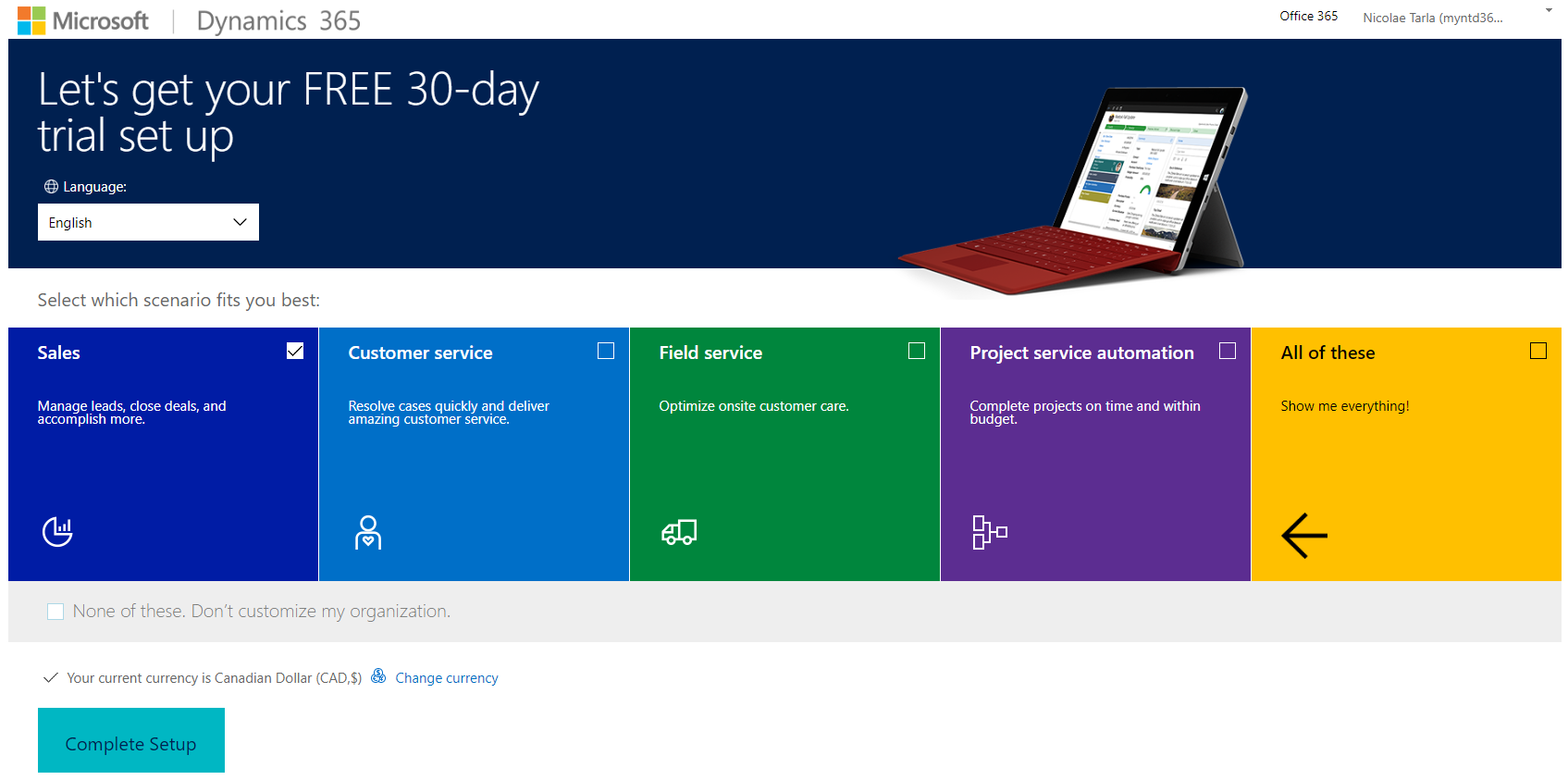
- Now, click on Complete Setup and grab a coffee because this takes a moment. Behind the scenes, a new instance in Dynamics 365 for Sales is created based on the configurations you provided during the setup wizard. This involves, among other things, creating a new Azure Active Directory that provides authentication, an Office 365 Admin portal for the configuration of services, and the Dynamics 365 tenant with the Sales application installed.
- When done, you will be forwarded to the newly created instance. Sample data will already be populated by default, but can easily be removed:
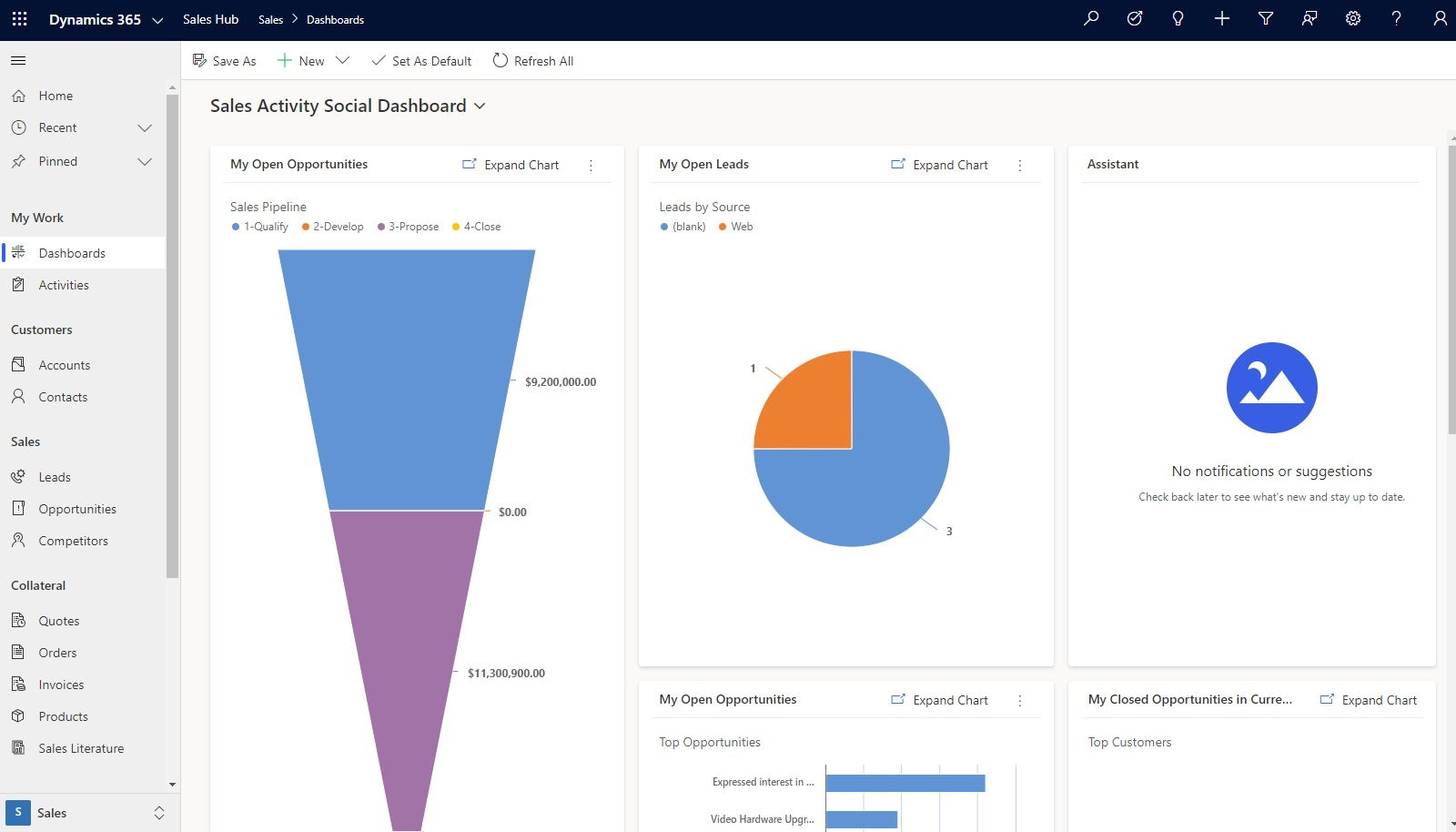
And with this, we now have a functional Dynamics 365 for Sales organization. We will be adding the additional modules as we get to review the functionality for each in the following chapters.
Once we have created the default instance, we can access it directly by the URL, which is going to be in the format https://[orgName].crm[x].dynamics.com, with [orgName] being the name of the organization you selected and crm[x] representing the geolocation of the data center that your instance is served from.
Note that once you have a domain configured, you can reference your current instance by the URL you configure for it, leveraging your domain name.
Now, let's check out the other ways in which can we access this instance.
Tenant access through the Office 365 Admin console
An alternative way to access this instance is by logging in to your Office 365 tenant at https://portal.office.com/ and following these steps:
- Log in using the previously created account and password. Once in, assuming that you are an admin and have the necessary permissions, you can navigate to the Microsoft 365 Admin Center, expand All Admin Centers, and find the Dynamics 365 Admin Center listed on the left side:
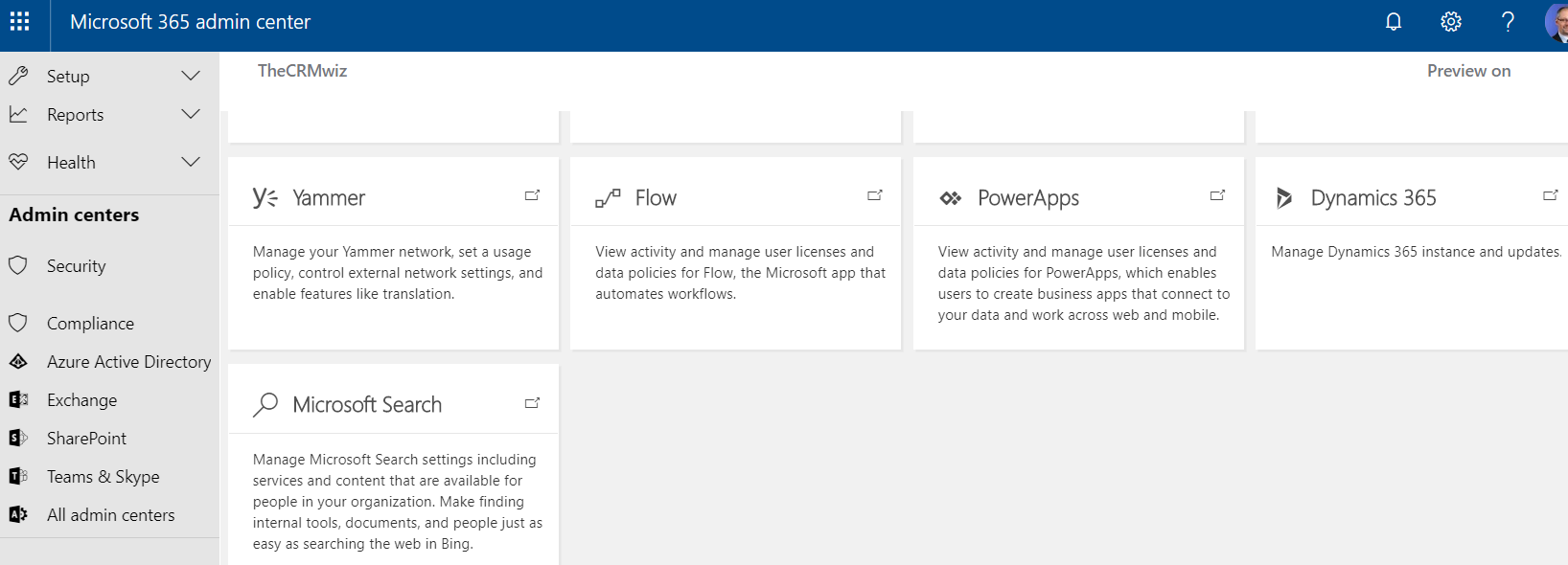
- This opens the Administration Center. Here, you will find your current trial organization. If you are on a paid subscription, you will get the opportunity to manage multiple paid production instances, as well as various nonproduction instances:
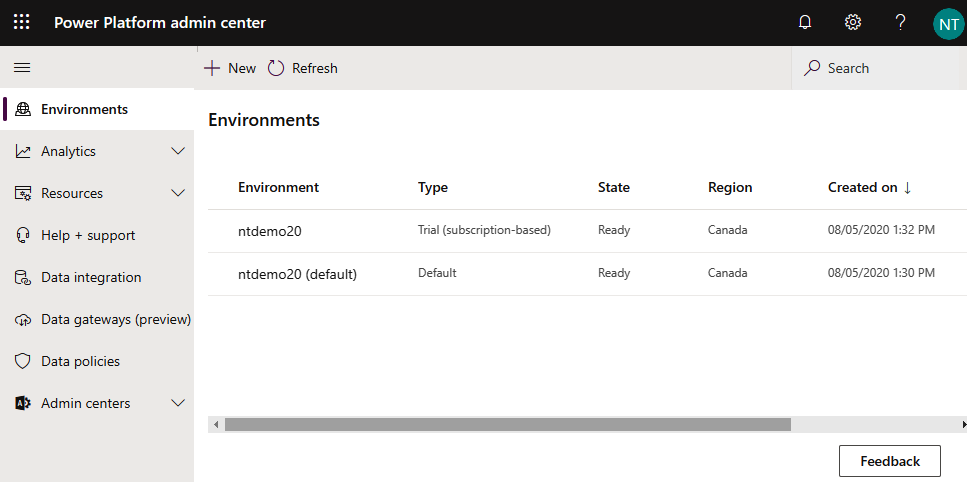
- You can navigate through the tabs at the top to see the available updates for your instances and the status of the service health and announcements, and manage backups and the various applications installed in your instances.
Back on the instances screen, we have the option to edit our instance properties. Selecting this option takes us to a form that allows us to change the name and URL of our organization, as well as provide a detailed message on the purpose of this organization. We can also copy our current instance to a new sandbox instance. This allows us to create a copy of a production instance for various tests. The notifications option allows us to configure additional users to be notified by email when administrative notices are distributed.
As you can see, besides the Production instance, we also get a Sandbox instance. In the next section, we will learn what the sandbox environment is.
What is a sandbox instance?
What are the different instance types, you might ask. Well, a Sandbox instance is basically a nonproduction instance. Depending on your licensing agreement, you could have one or more production instances, as well as several nonproduction sandbox instances. Once in an instance, a sandbox instance is clearly marked by a sandbox overlay over the top header.
From a functionality perspective, no functional changes are made to a sandbox instance. They offer the same functionality as a production instance. One very important aspect of sandbox instances is the fact that, while functionality is maintained on a par with production instances, the database is completely isolated from production. A sandbox instance can contain a full set or a subset of production data, users, and customizations.
As such, sandbox instances can be used for development, quality assurance (QA), and user acceptance testing (UAT) environments.
Finally, selecting the Open button allows you to open the selected instance and navigate directly to the application. Make sure that you have at least one security role assigned to your user in order to access an instance. Since you created this trial, you should have the Administrator role assigned.
The final chapter of this book deals with administration, and that's where we will come back to the Dynamics 365 Administration Center to visit the remaining tabs and options. Until then, let's focus on our current trial instance.
The trial instance of Dynamics 365 for Sales comes preloaded with some sample data. This makes it easy for a first-time user to see some of the visual representations on the dashboards, and also gives said user the opportunity to track some of the data relationships and see how related data is presented in certain records.
In the next few chapters, we will start investigating all the available features of the Dynamics 365 platform. For now, in the next section, let's learn more about how to configure a domain name for your environment.
Configuring a domain name for your environment
One of the setup steps available with an Office 365 instance is the ability to configure a domain name associated with your instance. While you can continue working with Dynamics 365 for Sales without setting up a domain, it is a good idea to do it now. With the domain setup, you have one less configuration step to take before turning your trial into a production instance. In order to provide a better user experience, you should always configure your domain before going to production.
If you want to proceed with setting up a domain, you can either use an existing domain that you own or, for a few dollars, you can purchase a domain from various registrars. For the purpose of this book, I have purchased a .info domain from GoDaddy at https://godaddy.com/.
Let's look at the steps to configure a domain, as follows:
- Access the Office 365 admin center by navigating to https://portal.office.com/.
- You will be prompted to log in. Use the previously created account; this will get you to the main admin center console:
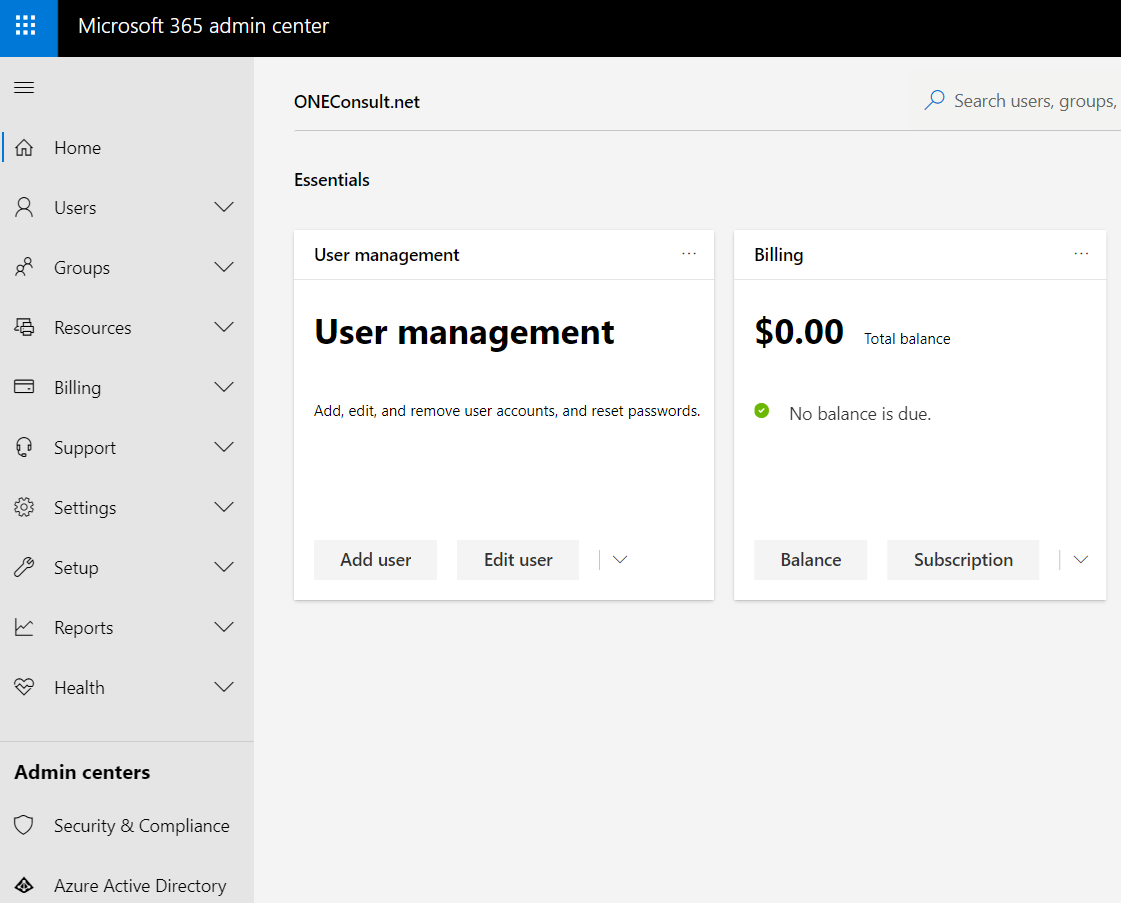
- Next, expand Setup and select Domains. Here, you have the option to purchase a domain (if you haven't already done so) or just add a new domain:
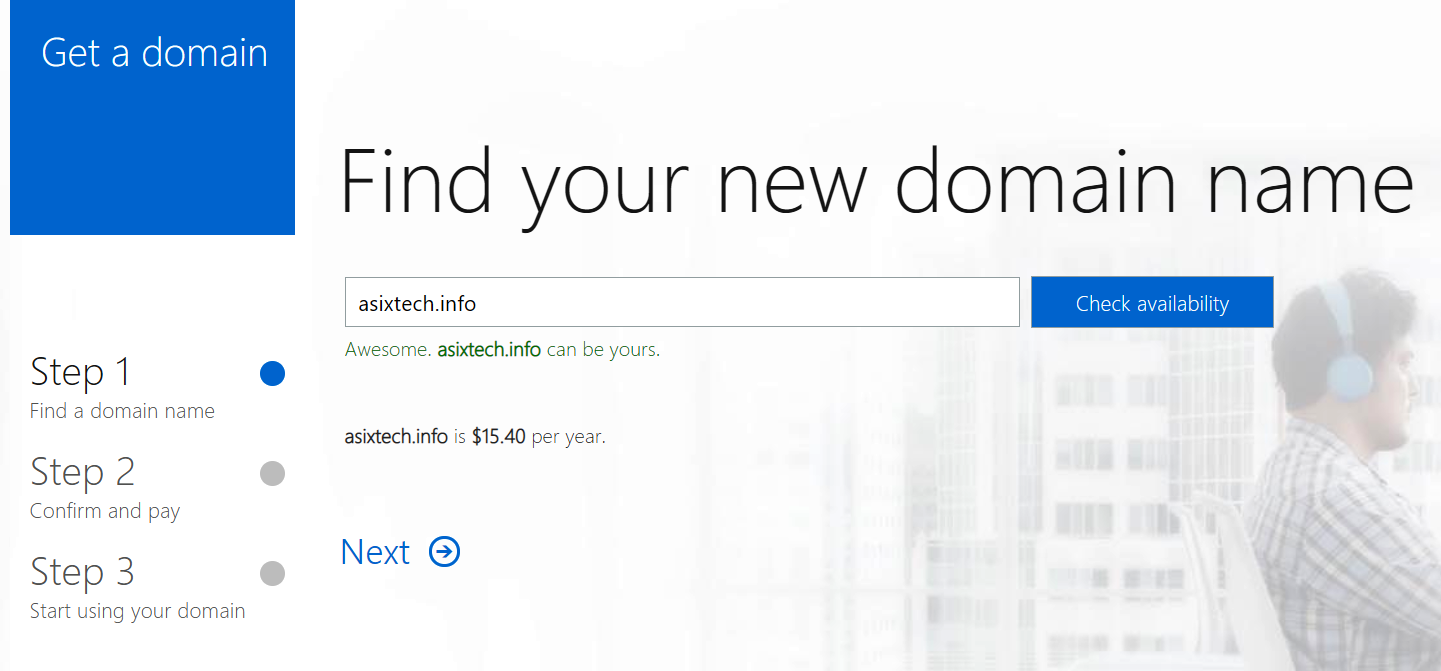
- Go to Add domain. This will take you to the first page of the domain configuration wizard. This first page displays a nice process flow at the top, showing the stages that you have to pass through to configure your new domain and collecting the domain details that you intend to use with your instance:
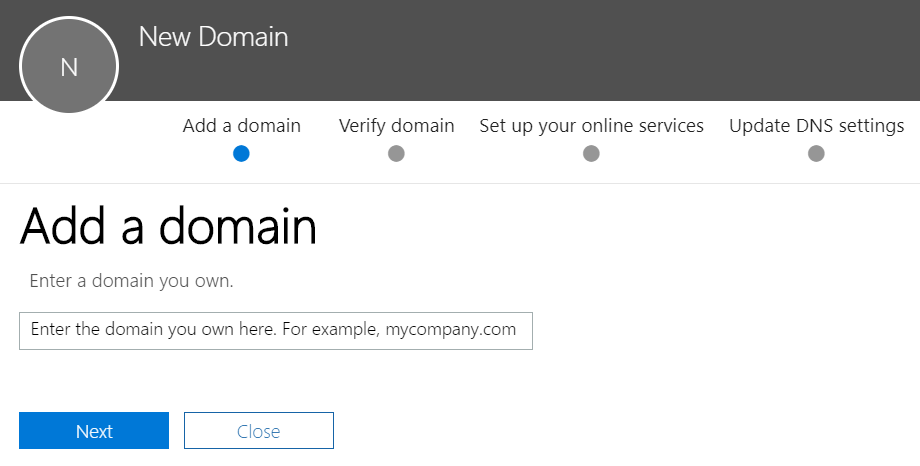
- Follow the wizard to complete the domain configuration. When it is done, in the administration console you will have the ability to grant your users the ability to use the added domain instead of the default @[orgName].onmicrosoft.com account names. Now it all looks much more professional, and you have one less step to configure when you decide to turn this into a production instance.
Let's have a look at the Office 365 services that are available to be configured and integrated with our platform.
Integrating with Office 365 E3 trial services
Office 365 is offered in a variety of flavors, each including a different set of services. One of the common tiers offered as a trial is the E3. It includes services such as the Office suite, email, document and file management, conferencing and Skype, team sites, and so on.
From your existing Office 365 instance where you created your Dynamics 365 for Sales trial, you can add this additional trial service by going through the following steps:
- Start by navigating on the left navigation area to BILLING | Purchase services.
- Find the Office apps and services section and scroll to find the Office 365 Enterprise E3 selection. Click on it:
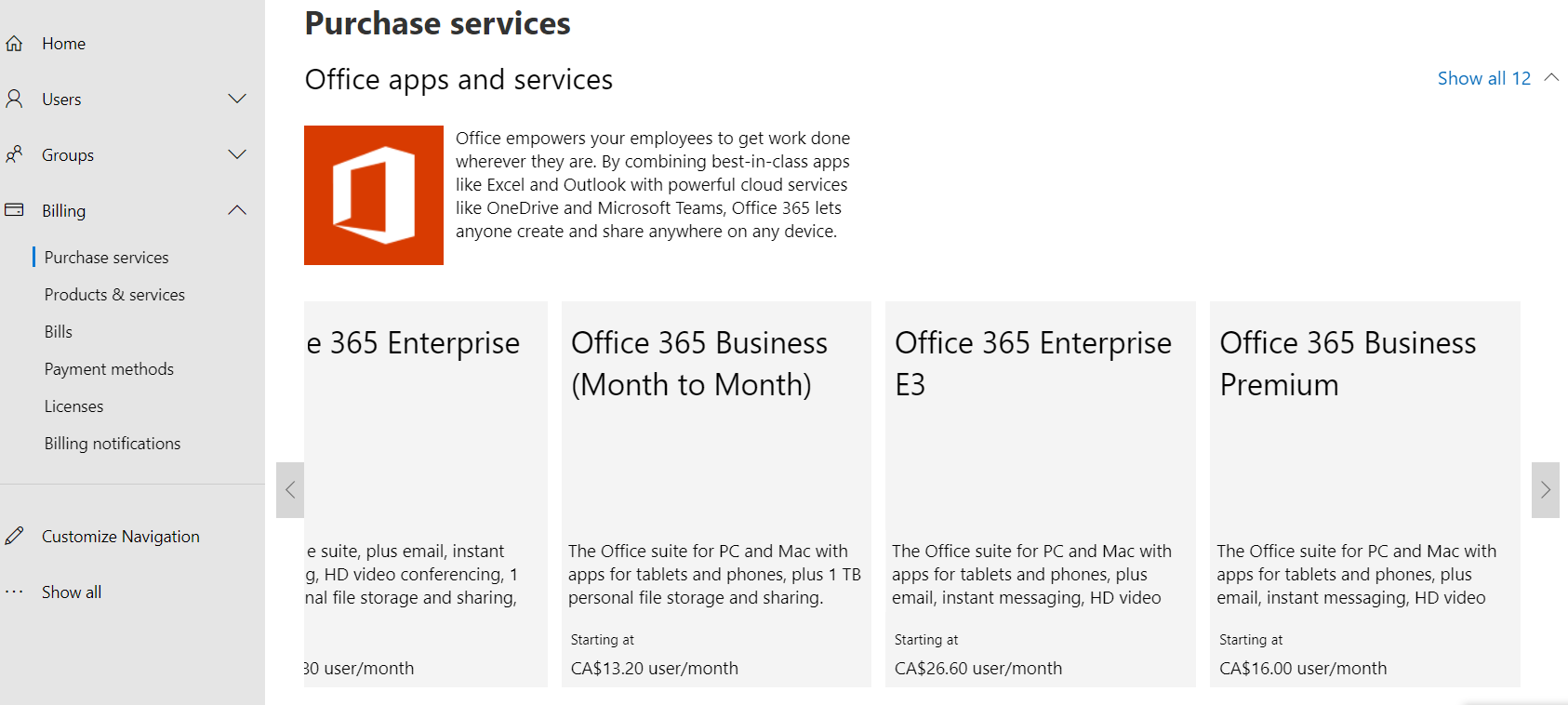
- On the page that opens, click the Get free trial button to add this trial to your existing instance:

- You will be asked to provide a valid mobile number for validation. A text message will be sent with a validation code. Once you complete the wizard, you will be asked to confirm your selection. Click the Try now button to activate this trial:
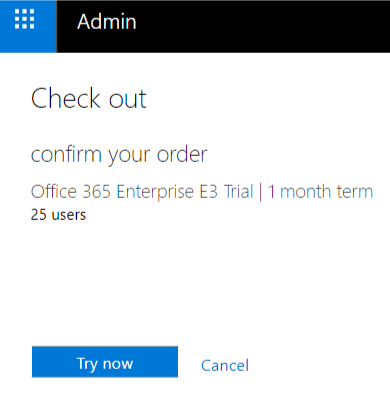
- And with that, all the additional services associated with the Office 365 Enterprise E3 services will be enabled and associated with your existing instance. To confirm, look at the expanded Billing section in the Admin center and select Products & services. You should see both trials listed with the available licenses:
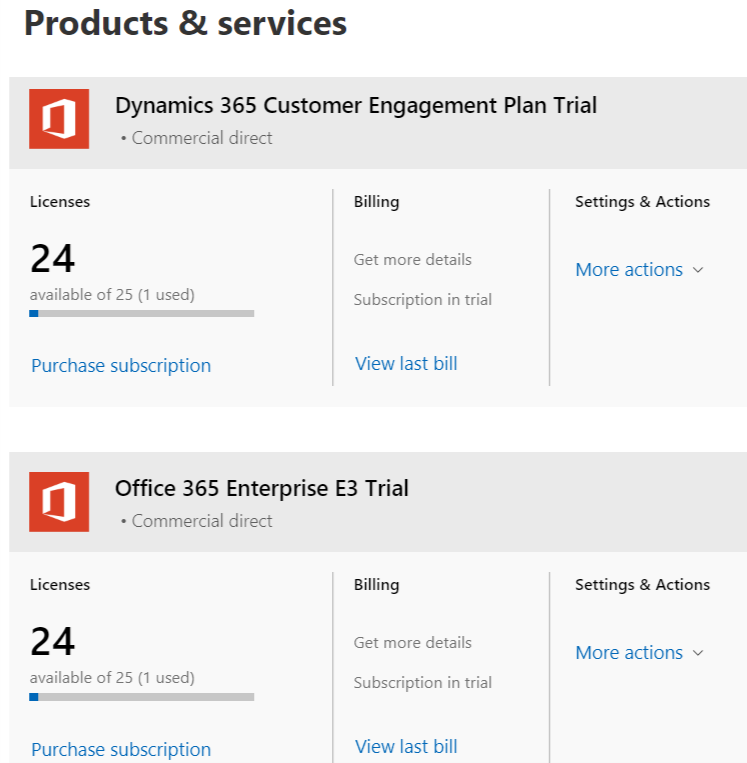
Now we can configure all of the default integrations that should be available. We will look at those tasks in some of the future chapters.
Summary
In this chapter, we looked at how to create a new free trial environment for Dynamics 365 for Sales.
We also learned how to add an Office 365 Enterprise E3 trial to our current Dynamics 365 trial in order to leverage the services that are available with the Office 365 service. This allows us to configure additional integration points; we'll be looking at these in future chapters.
We looked at the various geographical locations in which this service is hosted in Microsoft data centers and how it is served to various geographies. We learned that, while you should have your instance created in the closest geographical location for better performance, there are situations where you might want to deploy to a different location, or even to multiple locations for global organizations. That is a much more complex scenario and could involve different deployments and real-time synchronization of data.
The next chapter delves into the platform structure. We will look at the standard modules available with the platform, the elements that are available for customization, and their relationship to each module and each other.


























